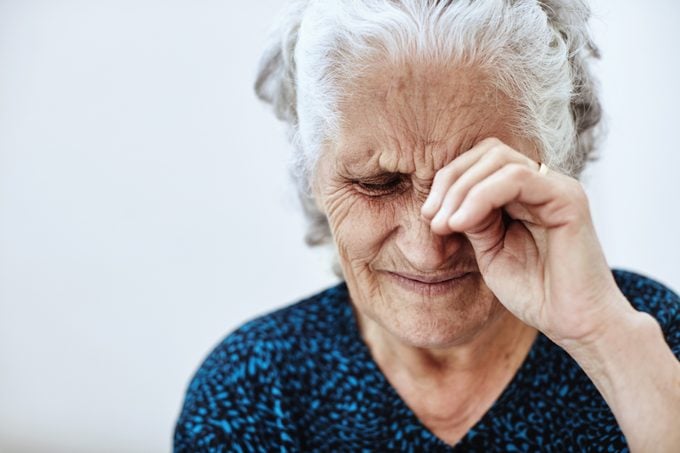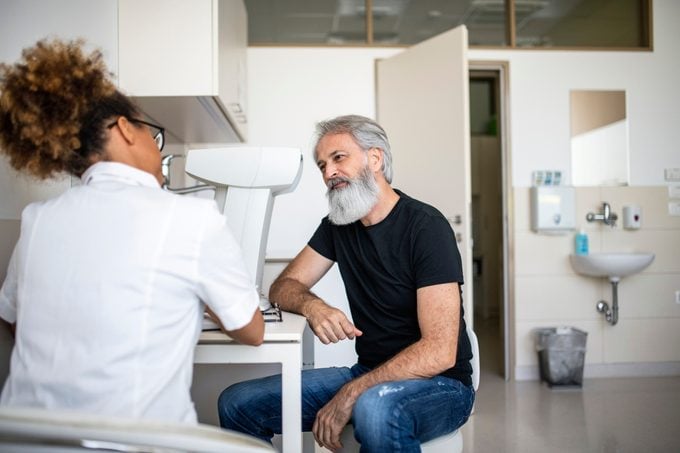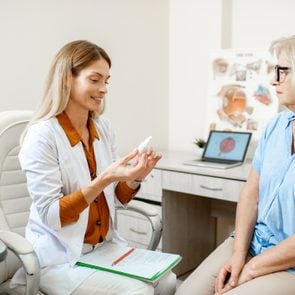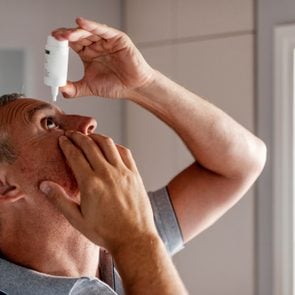Is There a Cure for Dry Eyes?
Updated: Dec. 23, 2021
From eye drops to hot compresses and lifestyle changes, managing dry eye disease can feel like a full-time job. Here's what's behind it, plus the leading-edge treatments renowned eye doctors are currently recommending.
Seeing red: the daily toll of dry eye disease
At her wedding, Abbie Livingston was able to wear the makeup she wanted, smile through every photograph, and look each of her guests right in the eye. Anyone she met that day might not have thought much of it. But the 16 million Americans who live with dry eye disease—often experiencing the world through a painful, burning lens—would appreciate the relief this bride felt for being able to set her sights entirely on her big day.
Livingston shares with TheHealthy that her experience with dry eyes started when was in college. “I didn’t really know what it was,” she says. Meanwhile, her eyes were so bloodshot and red-rimmed that it became normal for people stop and ask her if she was OK. Unfortunately using makeup wasn’t an option, since her doctor warned her that irritants in makeup products might work to worsen her symptoms. “It really was hard on my confidence,” Livingston says. Her quality of life suffered, too. It hurt to keep her eyes open, they’d continue to burn when she closed them, and she was sensitive to light.
In addition to the physical experience of living with dry eyes, one of the worst challenges with this condition is pinning down what causes it. Like many other chronic diseases, dry eyes syndrome is caused by multiple factors, says Kristyna Lensky Sipes, OD, an optometrist from Stanford Ranch Optometry in California. That makes the condition notoriously difficult to manage, treat, and live with day-to-day.
Adds Laura M. Periman, MD, of the Periman Eye Institute in Seattle, dry eye syndrome “has a wide variety of impacts on a patient, from their biology to their psychology to their sociology, their interactions with the world. We call it the ‘biopsychosocial’ impact on patients—and dry eye impacts all of it,” Dr. Periman says.
That’s why when Livingston’s dry eyes responded to a treatment called intense pulsed light (IPL), she went from coping as best she could into full wedding-planning mode. “My life completely changed,” she says.
Here’s information on what may be causing your discomfort, along with intense pulsed light and other long-term dry eye treatments.

What is dry eye disease?
“Dry eye disease is basically a tear film instability,” Dr. Lensky Sipes says. Your tear film is a thin, fluid-based layer that protects the eye, promotes wound healing, and helps maintain quality vision. Dr. Periman adds that in healthy eyes, the tears that support this layer quickly respond to environmental stressors—all without discomfort, visual disturbance, or your awareness.
But, this layer breaks down if there’s a loss of tear balance in your eyes. This generally results from:
- tear glands that do not produce enough tears, a problem known as “aqueous tear deficiency”
- tears evaporating too fast, known as “evaporative dry eye”
Dr. Lensky Sipes says that of the two, evaporative dry eye is far more common. In most cases, there’s inflammation around tiny oil glands that line your eyelids. This causes blockages that prevent the right balance of oil mixed into your tears—so they wind up evaporating faster than they should, leading to dry eye symptoms.
What are the symptoms of dry eye disease?
As a tear film instability, being diagnosed with dry eye disease just means that your tears aren’t working the way they should.
When it comes to identifying the symptoms of dry eye disease, Dr. Lensky Sipes says that sometimes, patients’ eyes actually feel very wet—and so they assume their issues stem from things like allergies. But she explains that tearing can be a sign of dry eye disease.
On the flip side, dry eyes can also cause dry, itchy, scratching sensations. Other common dry eye symptoms include:
- feeling like there’s something gritty or sandy in your eye
- burning, stinging, and redness
- blurry vision—including fluctuations throughout the day
- sharp pains in the eye
- eye heaviness and light sensitivity
“In the early stages, it’s typically more episodic,” Dr. Periman says. So, you might experience dry eye symptoms during allergy blooms, when you start a new medication, or after a long flight.
But over time, these episodes can become more frequent and last longer until the underlying cycle of inflammation is broken.
What causes dry eye disease?
Dry eye disease can develop from various factors, says Dr. Lensky Sipes. “Genetically, if we have certain systemic conditions like autoimmune diseases, we are more likely to have dry eye [as well],” she explains. Many common medications list dry eye as a side effect, including antidepressants, antihistamines, and painkillers.
Shifting hormone levels can also affect the glands in our eyes. That’s why women are more likely to have dry eyes than men—especially during pregnancy, menopause, and when using hormonal contraceptives or hormone replacement therapy.
Age may also play a role, according to research published in International Ophthalmology Clinics. But this distribution is changing. “[Dry eye] used to be considered predominantly a disease of post-menopausal females—and it turns out that the prevalence of dry eye in the 50 and above group is the same as the 21 to 49 [group],” says Dr. Periman. “So, it starts much earlier and younger than people realize.”
Today’s lifestyles may also disrupt the eye’s tear film and tear production…perhaps especially lately. That’s according to multiple studies—including one published in the International Journal of Occupational Safety and Ergonomics—which have found that rates of dry eye disease increased during the Covid-19 pandemic. Research published in The Ocular Surface found that their symptoms worsened during stay-at-home orders for those with pre-existing dry eye disease.
One explanation? “We’ve had a huge increase in computer and digital [device] use,” Dr. Lensky Sipes says. Between more screen time and spending days indoors with air conditioning or heating, the pandemic helped shape an environment that can upset our eyes’ natural balance.
Is there a way to cure dry eye disease permanently?

“Dry eye is a chronic condition,” Dr. Lensky Sipes says. “Similar to someone with hypertension or diabetes, it’s a long-term condition that needs to be managed and treated—but there’s not a cure.”
That said, the outlook for dry eye treatment continues to improve. “Dry eye is a very active field of research and innovation,” Dr. Periman says. “So we have more and more tools becoming available all the time.”
Here are some of the options and tools to consider.
Intense pulsed light therapy
One of these innovative treatments for dry eye is intense pulsed light (IPL). Dr. Lensky Sipes says the treatment works to decrease inflammation, unblocking the eye’s oil glands and restoring healthy function.
Research published in the journal Cornea found that about 86 percent of people with dry eye disease have some level of oil gland blockage. That’s why Dr. Lensky Sipes says that by helping to break this cycle of inflammation, the OptiLight has been a “game-changer” in her practice.
IPL therapy has been available since about 1995 to treat dermatological conditions like acne, rosacea, and wrinkles. But in May 2021, the U.S. Food and Drug Administration (FDA) approved the first IPL device designed to treat dry eye disease, the OptiLight.
She says that OptiLight dry eye treatment breaks down like this:
- Most people benefit from four treatment sessions, about two to four weeks apart.
- Each treatment takes about 10 to 15 minutes, all outpatient, and requires no downtime.
- Depending on the severity of someone’s dry eye disease, they may come in for “maintenance” sessions every six to 12 months.
Heat therapies
Thermal pulsation systems are close cousins to IPL therapy. They target the same root issue of many dry eye cases—inflamed oil glands—and a study from the International Journal of Health Sciences and Research found that the two approaches are comparably effective.
“I’m a big fan of Tearcare,” says Yuna Rapoport, MD, founder of Manhattan Eye and an assistant clinical professor of ophthalmology at Mount Sinai in New York City.
She explains that this therapy uses targeted heat to liquefy the oil in your eyelid glands. The warmth works to unclog glands so that the oil can properly lubricate your eyes.
“A procedure like this—or iLux or Lipiflow [two similar heat therapy systems]—is supposed to be like a deep cleaning procedure you do once or twice a year, similar to what you do in the dentist’s office,” she says.
Punctal plugs
A doctor can also place small inserts in your eyelid where your tears typically drain.
“[It’s] similar to putting a stopper in the sink drain—whatever tears are there will stay on the surface of the eye,” Dr. Rapoport says.
Two punctal plug options exist: temporary, dissolvable collagen plugs and permanent silicone plugs. “The collagen plugs are more comfortable and have fewer side effects than the silicone ones,” she explains. “But the silicone ones work slightly better and can be removed if issues arise.”
Dr. Rapoport says that patients can also choose to have their puncta—the drainage point for your tears—permanently closed.
Home care
While IPL therapy helps Livingston keep her dry eye symptoms under control, it’s not a cure. She emphasizes how it’s still important for her to practice healthy eye care routines and prepare for flare-ups.
That’s because even when therapies keep dry eye inflammation in check, anything that puts extra stress on the eyes can induce a symptomatic episode—like stress, travel, allergies, or increased screen time. “Now I have a series of protocols I go through when I start to feel like my eyelid is tender,” she says. “That’s when I move to the hot compresses, lubricating my eyes, keeping them clean, not touching them.”
Nutrition plays an important role in eye health, too. Dr. Lensky Sipes says that Omega-3 supplements can be very beneficial to the ocular surface, helping to decrease inflammation over time.
Learn more about home remedies for dry eye disease that help you feel better fast.
Which dry eye treatment is right for me?
“With dry eye, there isn’t a one-size-fits-all approach,” says Stephen Slade, MD, of Slade & Baker Vision in Houston and member of the Refractive Surgery Council editorial advisory board. “A thorough examination and complete medical history are needed to determine the exact origin of the problem, which strongly guides the treatment protocol,” he explains.
But just as treatment options are getting more effective, Dr. Slade says that diagnostic capabilities are advancing as well. Today’s tools allow doctors to closely measure various physiological factors that help paint a complete picture of what’s going on in your eyes.
“All of this data can give an eye doctor a good indication of the likely cause of dry eye and the treatments that are likely to address the specific problems,” he says. “There might be a bit of trial and error—but for most people, most of the time, they will get a good result from dry eye treatment.”



